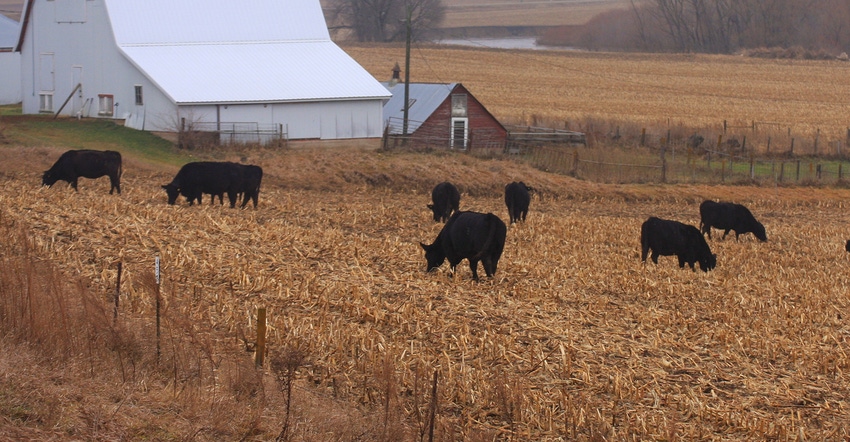September 20, 2018

By Stan Smith
I know I’ve shared this story before, but considering the weather most of Ohio has experienced this year, it’s appropriate to tell it again. Dad was a mechanic for a local farm implement dealer. Once, while out on a service call in midsummer, he asked the farmer if he’d gotten his first cutting of hay made. The response — in a deep German accent — was, “Yes, it got made ... but it rained so much I never got it baled.”
Despite that being the case in many parts again this year, we still have an abundance of feedstuffs available that will maintain beef cows efficiently when managed properly. With Ohio farmers harvesting more than 3 million acres of corn this year, a brood cow’s feed supply could easily be extended by using crop residue. Corn residue is practical for feeding dry, gestating beef cows in midgestation, providing they have average or better body condition. Plus, it’s also the perfect crop to use during the time perennial forages are being stockpiled.
Consider grazing efficiency
Grazing efficiency will determine exactly how much feed is realized from corn residue. Moveable electric fencing increases usability up to 50% by allowing control of the amount of area grazed, thus preventing cattle from selective grazing or trampling many of the leaves or husks. Strip grazing will also reduce the potential for acidosis in situations where there may have been excessive field losses of grain. Simply “dumping” cows onto the entire cornfield will be least efficient, but it will allow more residues to remain on the field over the winter for cover. Cattle will select and eat the grain first, then the husk and leaves, and finally the cobs and stalks.
If cornfields are not presently fenced, temporary electric fencing is an economical alternative. Depending on the field size and layout, harvested cornfields can be fenced with a single strand of poly or high-tensile wire supported with fiberglass posts for about $10 per acre. While corn residue offers a considerable amount of digestible energy and fiber, it’s always good to review the practicality of using the crop residues that result from either corn or soybean harvest as a significant feed source if they must be mechanically harvested and transported for feeding.
Even if a fence charger must be purchased, 30 to 45 days per acre of feed may be provided a typical Ohio brood cow at a cost under 25 cents per head per day. Plus, the materials purchased to provide this temporary fence may be reused from year to year, making the annual cost of ownership even less.
Despite Ohio farmers harvesting nearly 5 million acres of soybeans this fall, soybean stubble bales should be viewed as a last resort, unless a bale processor is available and stubble bales can be fed in limited quantities while mixed with other higher-quality feeds. In fact, if the vision for using soybean residue is simply placing bales of this “feed” in bale feeders, it’s probably not worth the effort and fuel it takes to gather it. While soybean residue can have 35% to 40% total digestible nutrients and nearly 4% protein, that’s even less than wheat straw. Soybean stubble might make marginal bedding — but frankly, tree twigs might make a comparable feed.
Cornstalks not very palatable
While corn residue has significantly more value than soybean residue as a feed source, and may be comparable to average grass hay, palatability of the stalks can be a problem. When it comes to baling and transporting corn residues, consumption versus waste must be considered. The husk, leaf, and any kernels in the bales will likely make up less than one-third of each bale but will be readily consumed. If a bale processor is used, it would make the stalks more palatable. However, when simply placing corn residue bales in rings, the abundance of cornstalks that remain will likely become bedding, after the more desirable parts of the bale are consumed. If baled corn residue must be fed in bale rings, simply disengage the chopper or spreader on the combine, and drop the residue that comes through the thresher in a windrow, baling only those windrows. The resulting bales will contain a much higher percentage of the palatable portions of the corn residue.
As one considers baling and transporting residue to brood cows, carefully consider harvest and transportation costs on a basis per consumable and digestible ton of dry matter. Also, when considering the economics of harvesting and hauling corn residues, be mindful of the fertilizer nutrients being removed from the cornfield and later left in a pile at the bottom of a bale ring. When removing a ton of corn crop residue from a field, it’s likely taking with it 6 pounds of P2O5 (phosphorus pentoxide and 25 pounds of K2O (potassium oxide). Soybean residue would remove only slightly less. Consideration must also be given to a negative effect: removal of crop residue decreasing soil organic matter.
Grazing corn crop residue can provide valuable feed while promoting soil health. However, carefully consider the pros and cons of mechanically harvesting and transporting residue to the cow herd. In almost every case, we discover managed grazing is by far the best way to use corn residue.
Smith is a program assistant at Ohio State University Extension’s Fairfield County office and a member of the OSU Extension Beef Team. The Beef Team publishes the weekly Ohio Beef Cattle letter, which can be received via email or found at beef.osu.edu.
You May Also Like




